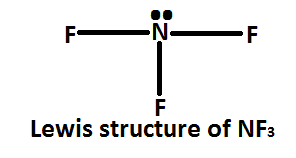
Hybridization of central atom in
Answer
463.5k+ views
Hint: Before solving the question we need to have some idea about hybridization. Hybridization is defined as the intermixing of two atomic orbits having the similar energy to produce a new different orbital, a new orbital which is produced known as hybrid orbitals. This process is called hybridization.
Complete step by step answer:
In Nitrogen trifluoride
The hybridization of nitrogen atoms in
Hence, in the

As we discussed above, the hybridisation of nitrogen atoms in
Note:
Valence Shell Electron Pair Repulsion Theory
Complete step by step answer:
In Nitrogen trifluoride
The hybridization of nitrogen atoms in
Hence, in the

As we discussed above, the hybridisation of nitrogen atoms in
Note:
Valence Shell Electron Pair Repulsion Theory
Recently Updated Pages
Master Class 12 Business Studies: Engaging Questions & Answers for Success

Master Class 12 English: Engaging Questions & Answers for Success

Master Class 12 Social Science: Engaging Questions & Answers for Success

Master Class 12 Chemistry: Engaging Questions & Answers for Success

Class 12 Question and Answer - Your Ultimate Solutions Guide

Master Class 11 Economics: Engaging Questions & Answers for Success

Trending doubts
Draw a labelled sketch of the human eye class 12 physics CBSE

a Tabulate the differences in the characteristics of class 12 chemistry CBSE

Which one of the following is a true fish A Jellyfish class 12 biology CBSE

Why is the cell called the structural and functional class 12 biology CBSE

Differentiate between homogeneous and heterogeneous class 12 chemistry CBSE

Write the difference between solid liquid and gas class 12 chemistry CBSE




